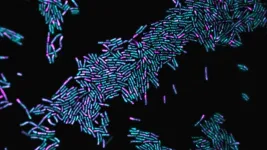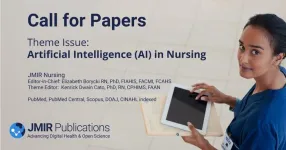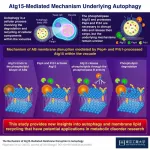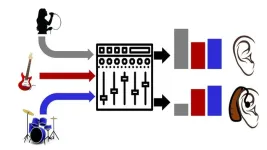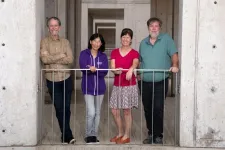(Press-News.org) Bacteria live in nearly every habitat on earth including within soil, water, acidic hot springs and even within our own guts.
Many are involved in fundamental processes like fermentation, decomposition and nitrogen fixation. But scientists don’t understand a fundamental process within bacteria cells: how they organize themselves before division.
Driving vs. surfing
When cells divide the cell splits into two “daughter cells” with the same genetic material as the original cell.
During this process, the DNA and other cellular components replicate, and then this “cargo” is shipped to opposite sides of the cell.
Once everything is in place, the cell splits down the middle to make two identical daughter cells.
The way eukaryotes (the cell type found in animals, plants, fungi, and some unicellular organisms) ship cellular cargo is well known. Protein motors drive along “highways” made of proteins called actin filaments and microtubules to pull DNA and organelles to opposite sides of the cell.
Bacteria don’t have microtubules or actin filaments, but still manage to coordinate movement within the cell.
As a student, Anthony Vecchiarelli, Ph.D., found it astounding that “we don’t know how things move within a cell for a whole domain of life.”
Now an affiliate faculty member in the University of Michigan Medical School Department of Biological Chemistry and assistant professor in the University of Michigan Department of Molecular, Cellular and Developmental Biology, Vecchiarelli along with a team of researchers conducted a study to better understand organization and movement coordination within a bacterial cell.
The University of Michigan researchers found some bacteria ship cellular cargo by “surfing” along proteins called ParA/MinD ATPases.
These proteins, or “positioning systems”, are even dedicated to shipping a single cellular component – each cargo has its own dedicated “surfboard”.
These movements, or “positioning reactions”, can influence one another, giving a clue to how bacteria coordinate complex movements in the cell prior to its division.
The results are published in Nature Communications.
A model bacteria
To achieve this, the research team first had to find a bacterium to study because the model species typically used in research to understand biological processes don’t have many positioning systems.
“A lot of the models that we use to understand how bacteria work suggested that there wasn’t really any intricate organization for all of these cargos,” said Vecchiarelli.
“There are some bacteria like plain old E. coli that seems to segregate its chromosomes without an active segregation system.”
Using bioinformatics techniques to sift through genetic information across bacteria was the first step to determine the prevalence of active positioning systems.
“We found over a third of all sequenced bacteria do encode for multiple positioning systems for multiple disparate cargos in the same cell. E. coli is an exception to the norm,” Vecchiarelli said.
The research team selected a bacteria called Halothiobacillus neapolitanus to study as it has seven different positioning systems for seven different cargos.
Vecchiarelli’s graduate student, Lisa T. Pulianmackal, learned how to cultivate this bacterial species in the lab and fluorescently label five cargos, allowing the researchers to follow their movement in live cells through cell growth and division.
She then deleted each positioning system to show how each one is dedicated to a specific cargo.
The next step was the systems level approach to see how these cargo movements interact with one another.
Systems biology approach
Often, researchers focus on a single biological process. They make a mutation and then see if that specific process was influenced. This approach can miss indirect consequences of that mutation.
This study is one of the first to use a systems biology approach on spatial organization in a bacteria cell.
“We find that there is a lot of crosstalk, interdependencies, and coordination among these organizing processes,” Vecchiarelli said. “That’s why the systems biology approach is so important.”
Future applications
The results offer exciting new prospects in biotechnological developments.
Each positioning system is made of an ATPase and its adapter protein, or surfboard, which connects to the cargo. This offers an opportunity to develop a synthetic biology tool allowing researchers to position any cargo they choose by connecting to the adapter.
“Now that we identified five different positioning systems that work together, we are hoping to develop a synthetic biology toolset for positioning a wide variety of synthetic as well as natural cargos in bacteria for biotechnological applications,” Vecchiarelli explained.
Researchers also plan to investigate cargo movement in medically relevant microbes like pathogens, or disease-causing bacteria.
“For bacterial pathogens, understanding how to break the surfboard can help us design new antibiotics,” Vecchiarelli said.
END
How bacteria surf cargo through the cell
Study offers new insight into how bacteria coordinate movement within the cell before division
2023-08-22
ELSE PRESS RELEASES FROM THIS DATE:
JMIR Nursing Call for Papers Theme Issue on Artificial Intelligence (AI) in Nursing
2023-08-22
JMIR Nursing Editor-in-Chief: Elizabeth Borycki RN, PhD, FIAHIS, FACMI, FCAHS and theme editor Kenrick Dwain Cato, PhD, RN, CPHIMS, FAAN welcome submissions to a special theme issue examining "Artificial Intelligence (AI) in Nursing."
AI is revolutionizing health care. Nurse informaticist developers, researchers, practitioners, clinicians, educators, and innovators have designed, developed, implemented, and used AI to support patients, their families, nurses and health care activities.
AI has been used to support ...
New study sheds light on the molecular mechanisms underlying SLC29A3 disorders
2023-08-22
In humans, the SLC29A3 gene regulates the function of lysosomes to control waste recycling in cells such as macrophages (that engulf and destroy foreign bodies). This gene encodes for the lysosomal protein that transport nucleosides — degradation products of RNA and DNA — from lysosomes to the cytoplasm. Loss-of-function mutations in the SLC29A3 gene lead to aberrant nucleoside storage, resulting in a spectrum of conditions called SLC29A3 disorders. These disorders can manifest in the form of pigmented skin patches, enlargement of the liver/spleen, hearing loss, or type 1 diabetes. A key manifestation of this group of disorders is histiocytosis, ...
MPFI's Wang Lab awarded $1 million grant to study mechanism behind memory decline in Alzheimer’s
2023-08-22
Max Planck Florida will be able to expand their research program to investigate the neural circuits underlying Alzheimer’s disease with new support. The National Institute on Aging of the NIH has awarded Dr. Yingxue Wang $1,038,819 over three years as part of the Alzheimer’s Disease Initiative Fund. The research will shed new light on how the brain forms new memories and maintains them over time and what can lead to memory decline during Alzheimer’s Disease.
Turning our daily experiences ...
USPSTF recommendation on preexposure prophylaxis to prevent acquisition of HIV
2023-08-22
Bottom Line: The U.S. Preventive Services Task Force (USPSTF) recommends that clinicians prescribe preexposure prophylaxis using effective antiretroviral therapy to persons at increased risk of HIV acquisition to decrease the risk of acquiring HIV. An estimated 1.2 million persons in the U.S. currently have HIV, and more than 760,000 persons have died of complications related to HIV since the first cases were reported in 1981. Although treatable, HIV is not curable and has significant health consequences. Therefore, effective strategies to prevent HIV are an important public health and ...
This fish doesn't just see with its eyes -- it also sees with its skin.
2023-08-22
DURHAM, N.C. -- A few years ago while on a fishing trip in the Florida Keys, biologist Lori Schweikert came face to face with an unusual quick-change act. She reeled in a pointy-snouted reef fish called a hogfish and threw it onboard. But later when she went to put it in a cooler she noticed something odd: its skin had taken on the same color and pattern as the deck of the boat.
A common fish in the western Atlantic Ocean from North Carolina to Brazil, the hogfish is known for its color-changing skin. ...
New antibiotic from microbial ‘dark matter’ could be powerful weapon against superbugs
2023-08-22
A new powerful antibiotic, isolated from bacteria that could not be studied before, seems capable to combat harmful bacteria and even multi-resistant ‘superbugs’. Named Clovibactin, the antibiotic appears to kill bacteria in an unusual way, making it more difficult for bacteria to develop any resistance against it. Researchers from Utrecht University, Bonn University (Germany), the German Center for Infection Research (DZIF), Northeastern University of Boston (USA), and the company NovoBiotic Pharmaceuticals (Cambridge, USA) now share the discovery of Clovibactin and its killing mechanism in the scientific journal Cell.
Urgent need for new antibiotics
Antimicrobial ...
Effect of a Mediterranean diet or mindfulness-based stress reduction during pregnancy on child neurodevelopment
2023-08-22
About The Study: In this randomized clinical trial that included 626 children, maternal structured lifestyle interventions during pregnancy based on a Mediterranean diet or mindfulness-based stress reduction significantly improved child neurodevelopmental outcomes at age 2.
Authors: Francesca Crovetto, M.D., Ph.D., of the University of Barcelona in Barcelona, Spain, is the corresponding author.
To access the embargoed study: Visit our For The Media website at this link https://media.jamanetwork.com/
(doi:10.1001/jamanetworkopen.2023.30255)
Editor’s Note: Please see the article for additional information, including ...
Comparison of ophthalmologist and AI chatbot responses to online patient eye care questions
2023-08-22
About The Study: In this study of human-written and artificial intelligence (AI)-generated responses to 200 eye care questions from an online advice forum, a chatbot appeared capable of responding to long user-written eye health posts and largely generated appropriate responses that did not differ significantly from ophthalmologist-written responses in terms of incorrect information, likelihood of harm, extent of harm, or deviation from ophthalmologist community standards.
Authors: Sophia Y. Wang, M.D., M.S., of Stanford University in Stanford, California, is the corresponding author.
To access the embargoed ...
Hard-of-hearing music fans prefer a different sound
2023-08-22
WASHINGTON, August 22, 2023 – Millions of people around the world experience some form of hearing loss, resulting in negative impacts to their health and quality of life. Treatments exist in the form of hearing aids and cochlear implants, but these assistive devices cannot replace the full functionality of human hearing and remain inaccessible for most people. Auditory experiences, such as speech and music, are affected the most.
In JASA, published on behalf of the Acoustical Society of America by AIP Publishing, researchers from the University of Oldenburg studied the impact of hearing loss on subjects’ enjoyment of different ...
High-fat diets alter gut bacteria, boosting colorectal cancer risk in mice
2023-08-22
LA JOLLA (August 22, 2023)—The prevalence of colorectal cancer in people under the age of 50 has risen in recent decades. One suspected reason: the increasing rate of obesity and high-fat diets. Now, researchers at the Salk Institute and UC San Diego have discovered how high-fat diets can change gut bacteria and alter digestive molecules called bile acids that are modified by those bacteria, predisposing mice to colorectal cancer.
In the study, published in Cell Reports on August 22, 2023, the team found increased levels of specific gut bacteria in mice fed high-fat diets. Those gut bacteria, they ...
LAST 30 PRESS RELEASES:
Short-circuiting pancreatic cancer
Groundbreaking mapping: how many ghost particles all the Milky Way’s stars send towards Earth
JBNU researchers propose hierarchical porous copper nanosheet-based triboelectric nanogenerators
A high-protein diet can defeat cholera infection
A more accurate way of calculating the value of a healthy year of life
What causes some people’s gut microbes to produce high alcohol levels?
Global study reveals widespread burning of plastic for heating and cooking
MIT study shows pills that communicate from the stomach could improve medication adherence
Searching for the centromere: diversity in pathways key for cell division
Behind nature’s blueprints
Researchers search for why some people’s gut microbes produce high alcohol levels
Researchers find promising new way to boost the immune response to cancer
Coffee as a staining agent substitute in electron microscopy
Revealing the diversity of olfactory receptors in hagfish and its implications for early vertebrate evolution
Development of an ultrasonic sensor capable of cuffless, non-invasive blood pressure measurement
Longer treatment with medications for opioid use disorder is associated with greater probability of survival
Strategy over morality can help conservation campaigns reduce ivory demand, research shows
Rising temperatures reshape microbial carbon cycling during animal carcass decomposition in water
Achieving ultra-low-power explosive jumps via locust bio-hybrid muscle actuators
Plant-derived phenolic acids revive the power of tetracycline against drug-resistant bacteria
Cooperation: A costly affair in bacterial social behaviour?
Viruses in wastewater: Silent drivers of pollution removal and antibiotic resistance
Sub-iethal water disinfection may accelerate the spread of antibiotic resistance
Three in four new Australian moms struggle with body image
Post-stroke injection protects the brain in preclinical study
Cardiovascular risk score predicts multiple eye diseases
Health: estimated one in ten British adults used or interested in GLP-1 medications for weight loss
Exercise to treat depression yields similar results to therapy
Whooping cough vaccination for pregnant women strengthens babies’ immune system
Dramatic decline in new cases of orphanhood in Uganda driven by HIV treatment and prevention programs
[Press-News.org] How bacteria surf cargo through the cellStudy offers new insight into how bacteria coordinate movement within the cell before division
